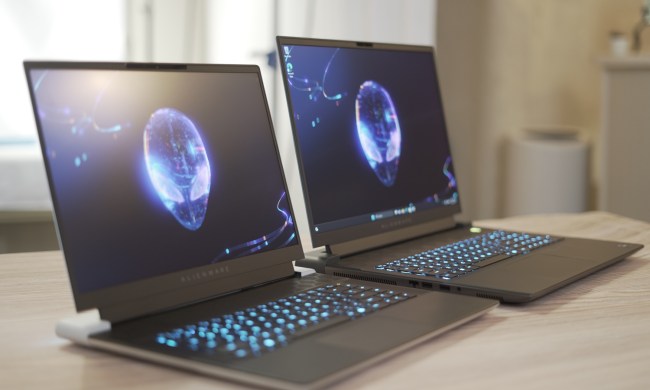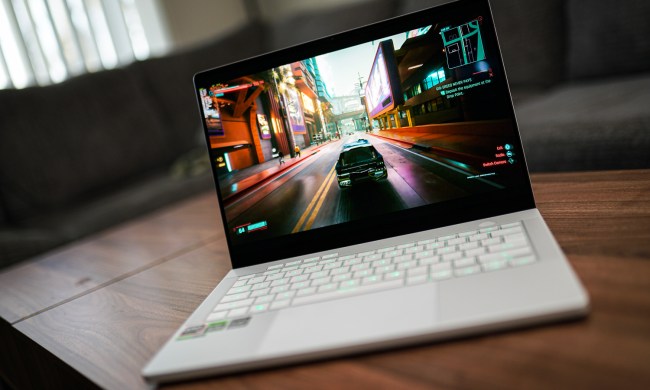Sixteen-inch gaming laptops are top of mind in 2023, and two models stand out from the pack: Asus’ ROG Zephryus M16 and Razer’s updated Blade 16. Both come with stunning screens, next-gen hardware, and stellar build quality, but which one comes out on top?
We’re still waiting on further testing and our own hands-on time with both laptops, but you can already discern a lot from the spec sheet. Here’s how the Asus ROG Zephyrus M16 stacks up to the new Razer Blade 16.
Specs
| Razer Blade 16 | ROG Zephyrus M16 2023 | |
| Dimensions | 13.98 x 9.61 x 0.87 inches | 13.98 x 9.70 x 0.88 inches |
| Weight | 4.4 pounds | 4.6 pounds |
| Processor | Intel Core i9-13950HX | Intel Core i9-13900H |
| Graphics | Nvidia GeForce RTX 4060 Nvidia GeForce RTX 4070 Nvidia GeForce RTX 4080 Nvidia GeForce RTX 4090 |
Nvidia GeForce RTX 4070 Nvidia GeForce RTX 4080 Nvidia GeForce RTX 4090 |
| RAM | 16GB or 32GB; DDR5-5600 | Up to 64GB DDR5-4800 |
| Display | 16-inch IPS LED, 2560 X 1600, 240Hz 16-inch mini-LED, dual-mode display with 3840 x 2400 120Hz or 1920 x 1200 240Hz options |
16-inch IPS, 2560 X 1600, 240Hz 16-inch mini-LED, QHD+ (3200 x 1800), 240Hz |
| Storage | Up to 4TB | Up to 2TB Additional SSD slot |
| Ports | 1 x 3.5mm audio jack 1 x USB-C Thunderbolt 4 1x USB-C 3.2 Gen 2 3x USB-A 3.2 Gen 2 1x HDMI 2.1 1x microSD card slot |
1 x 3.5mm audio jack 1 x USB-C Thunderbolt 4 1 x USB-C 3.2 Gen 2 2 x USB-A 3.2 Gen 1 1 x HDMI 2.1 1 x microSD card slot |
| Wireless | Wi-Fi 6E and Bluetooth 5.3 | Wi-Fi 6E and Bluetooth 5.3 |
| Webcam | 1080p with IR camera for Windows 11 Hello | 1080p with IR camera for Windows 11 Hello |
| Operating system | Windows 11 | Windows 11 |
| Battery | 95.2 watt-hour | 90 watt-hour |
| Price | $2,700 and above | TBD |
Design

Both the Razer Blade 16 and the Asus ROG Zephyrus M16 see some new design changes compared to their previous iterations. We’re getting some display upgrades for both, but more on that later.
For the ROG Zephyrus M16, the design upgrades aren’t huge. It gets a slightly updated chassis compared to the older model, switching to a magnesium alloy model with an aluminum lid. You can also get it with Asus’ AniMe Matrix backlit lid, which lets you customize your laptop in a fun way. We’ve seen this tech in laptops before, including the ROG Zephyrus G14, as well as in peripherals. It’s a funky addition that doesn’t change anything in the way of performance, but it certainly doesn’t hurt.
Now, for Razer, the changes are bigger. For starters, this is the first Blade to come out in a 16-inch variant, alongside another new model, the Razer Blade 18.
Razer finally made the switch to the increasingly popular 16:10 aspect ratio with these models, meaning that the bottom bezel is much thinner. Unfortunately, the cooling system remains the same as it was in the smaller Razer Blade 15. This shouldn’t indicate massive thermal issues, but with the number of high-end components packed inside the laptop, we might see it run a little hot during intense gaming sessions.
Both laptops share nearly the same measurements and weight, with the Asus model being around 0.33 pounds lighter than the Razer. Connectivity is just about the same in each, and both have a 1080p webcam. The Razer has a bit more battery life, but these gaming laptops are usually plugged in anyway.
Performance
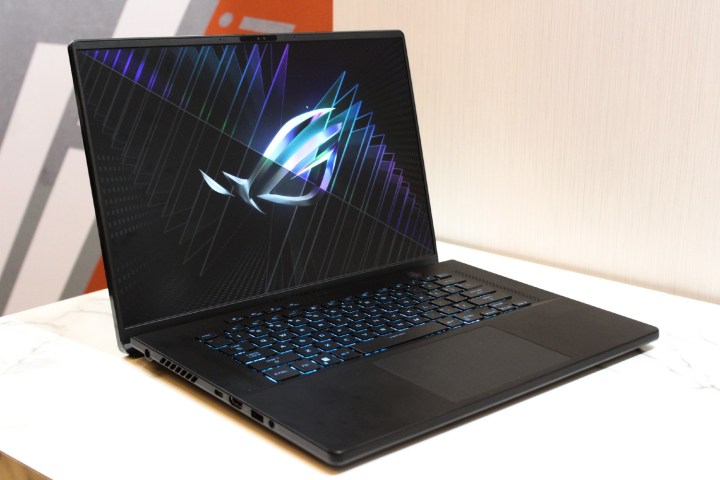
The two laptops are still on their way to the market and aren’t widely available just yet, so there aren’t many benchmarks to browse through. However, this should change in the next few weeks.
With that said, there are a few things to be said about each. They’re fairly close in terms of specifications. Both sport an Intel Core i9 processor from the latest Raptor Lake lineup, but the Razer Blade has a better model: the Core i9-13950HX features 24 cores and 32 threads, whereas the Core i9-13900H maxes out at 14 cores and 20 threads. The clock speed inches slightly higher (5.5GHz versus 5.4GHz) for the Core i9-13950HX, too.
The Razer Blade 16 offers a robust selection of Nvidia’s RTX 40-series mobile graphics cards, but the Asus model is not far behind in that regard. In the most expensive configuration, you get access to Nvidia’s best GPU by a mile, the RTX 4090. However, we’re also seeing a slight disadvantage for the ROG Zephyrus M16 here, because the GPU maxes out at 145 watts with dynamic boosting. Meanwhile, the RTX 4090 in the Razer Blade 16 goes up to 175W, which could give it a little extra room to hit higher frames per second (fps).
Early insights into the Asus ROG Zephyrus M16 show that the laptop handles itself well in gaming scenarios. The power limit can make the Razer Blade 16 pull ahead, though. It’s especially visible because the default Performance mode on the laptop only allows the GPU to consume 85W, which drastically cuts down on the performance. Running the laptop in Turbo mode should unlock the true potential of the RTX 4090, however, and that includes running AAA titles on ultra settings and still reaching high fps. The same can be said of the Razer Blade 16, although it might turn out to be a little better.
Ultimately, nearly every opinion about these two laptops sounds like a love letter to the mobile version of the Nvidia GeForce RTX 4090. The GPU is monstrous even in its cut-down laptop version (read our MSI GT77 Titan review for reference), and it enables high-end gaming with ray tracing enabled.
Displays
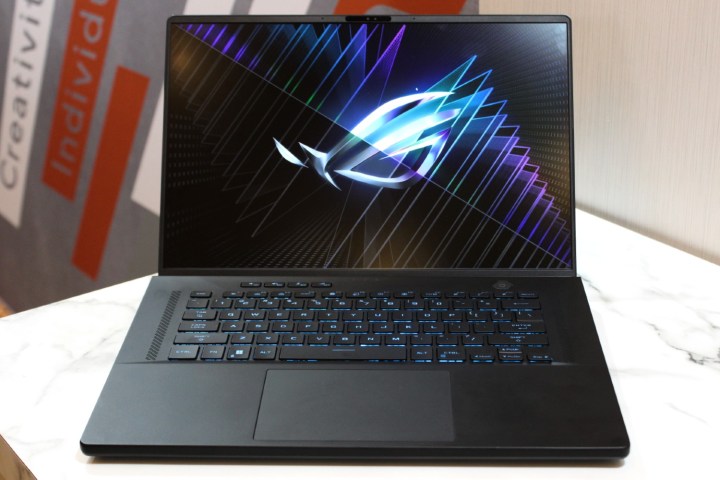
Bleeding-edge hardware aside, it’s the displays that make both of these laptops stand out from the crowd. Just a few years ago, the display was more of an afterthought in gaming laptops, but these days, high-end notebooks sport screens that could rival some of the best gaming monitors.
The Asus ROG Zephyrus M16 gets a massive overhaul by being upgraded to Asus’ Nebula HDR display. This is a mini-LED screen with 1,024 local dimming zones, which means that it’s intensely bright. It can reach as high as 1,100 nits of peak brightness in HDR. Fortunately, Asus didn’t need to make any sacrifices when it comes to the refresh rate — we’re getting a comfortable 240Hz that will fly through esports games.
The Razer Blade 16 also offers a mini-LED screen, with an interesting caveat — it can also come with a dual-screen mode display. Depending on what you’re currently doing, you can swap between 4K resolution with a 120Hz refresh rate and 1200p with 240Hz. The former will be much sharper, and the latter will be perfect for gaming. Unfortunately, you’ll have to reboot the laptop to switch the display mode. The mini-LED panel maxes out at 1,000 nits of peak HDR brightness, which is not far behind the Asus model; it still offers some stunning visuals.
Two outstanding laptops
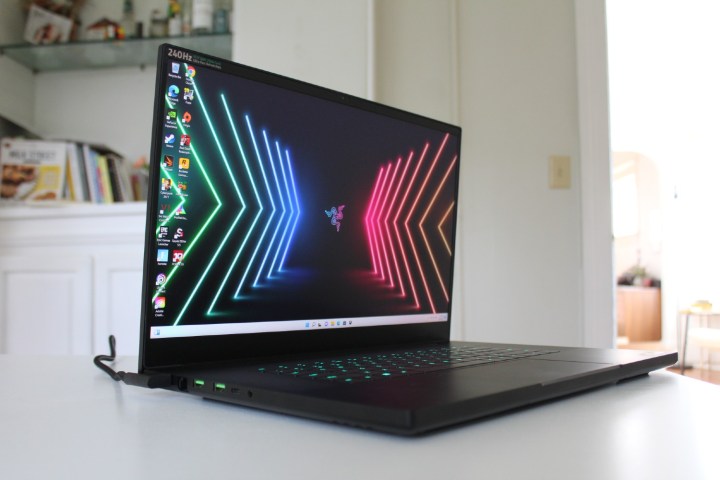
Without performing our own in-depth testing of the Razer Blade 16 and the Asus ROG Zephyrus M16, we don’t have the exact figures needed to judge their performance. However, it’s safe to assume that the Razer model may pull ahead — but not by a massive margin.
Each laptop can be configured to suit your needs. Razer offers up access to an RTX 4060 and Asus starts with an RTX 4070, but ultimately, each can go all the way up to the RTX 4090. These models will, of course, have eye-watering prices — but that’s the cost of a high-end gaming laptop these days. The Blade 16 with the RTX 4090 and 32GB of RAM costs a whopping $4,300; we can expect the Asus model to be similarly priced, although maybe a little bit cheaper.
The Razer Blade 16 might be the better pick as far as performance goes, and the dual-mode display is a fun addition that makes it easier to switch between work and gaming time.
The best advice right now would be to wait for more benchmarks to come out, but if you want to jump in and pre-order one of these laptops, choose between raw performance and visuals. For pure performance, pick up the Razer, but for pure visuals, you might enjoy the static-but-gorgeously bright ROG Zephyrus M16.


